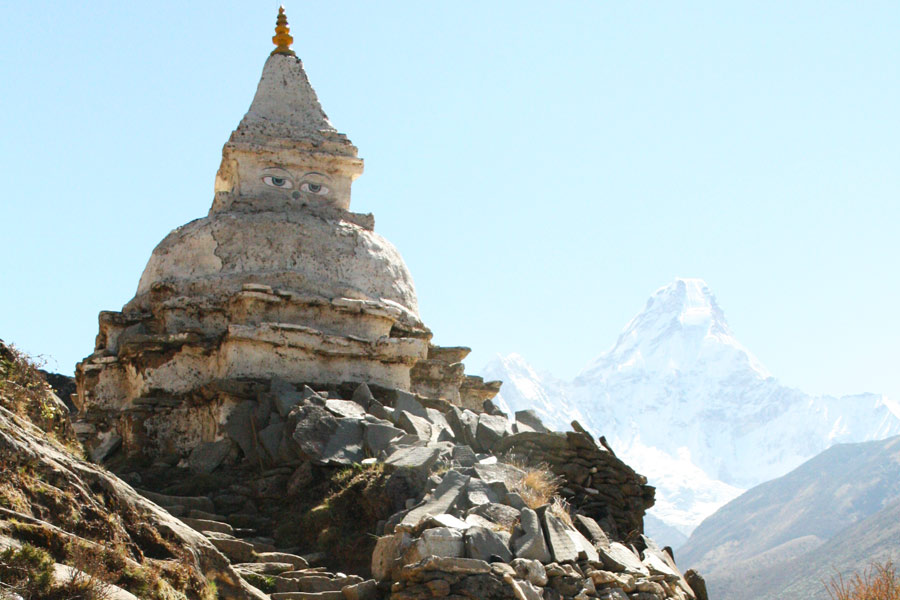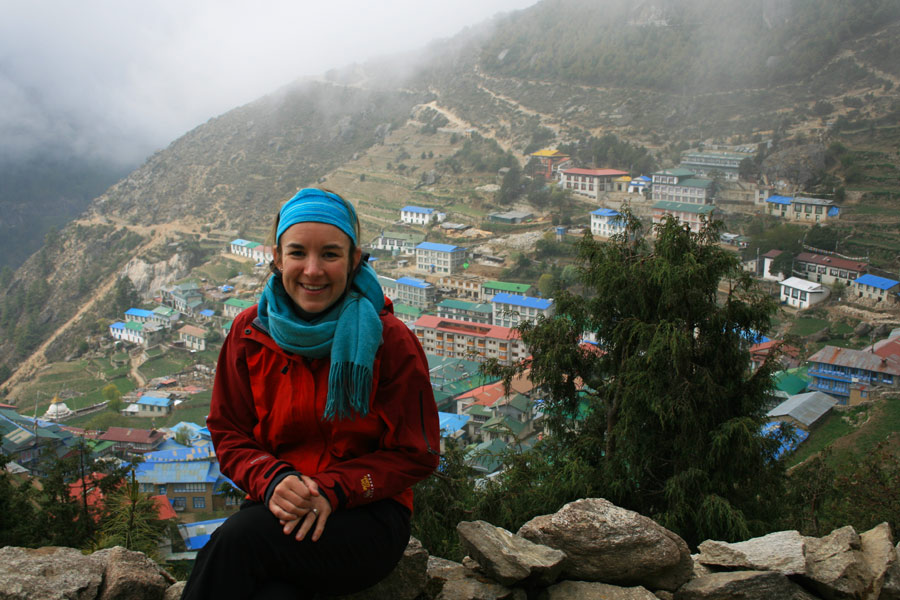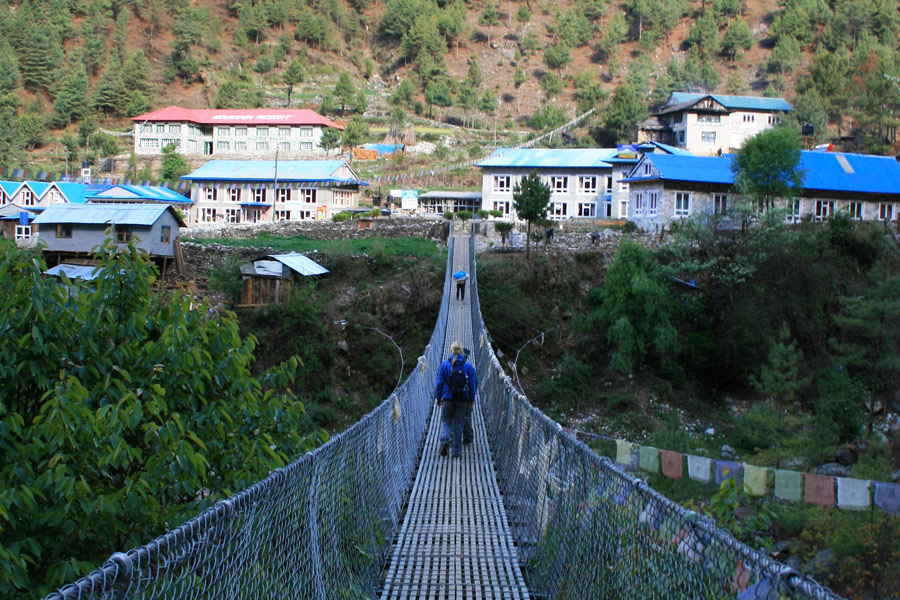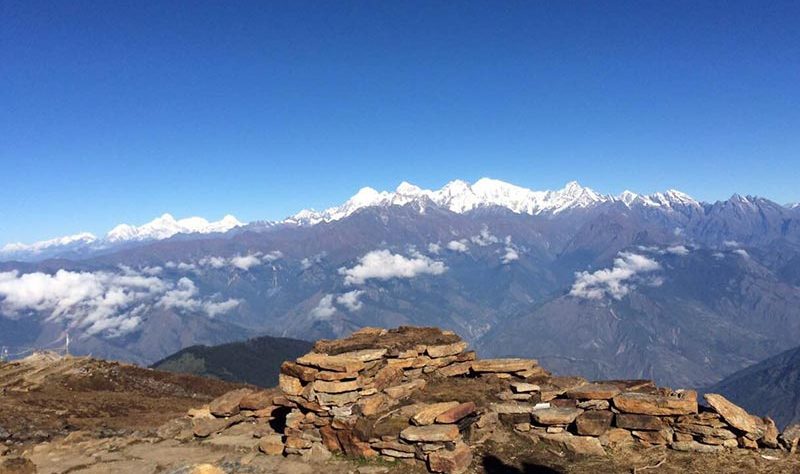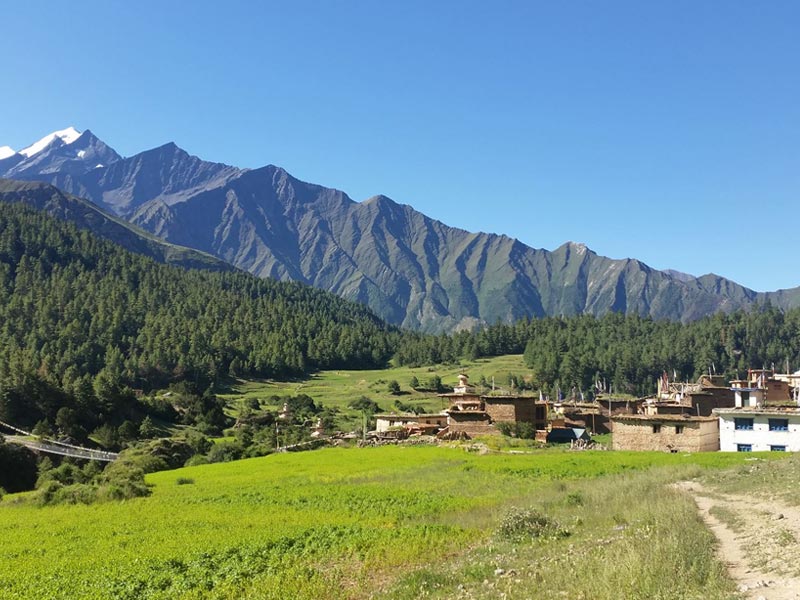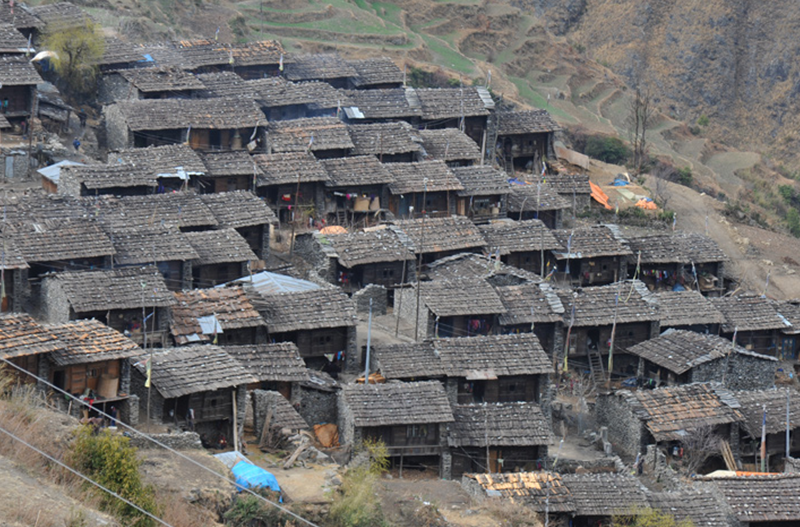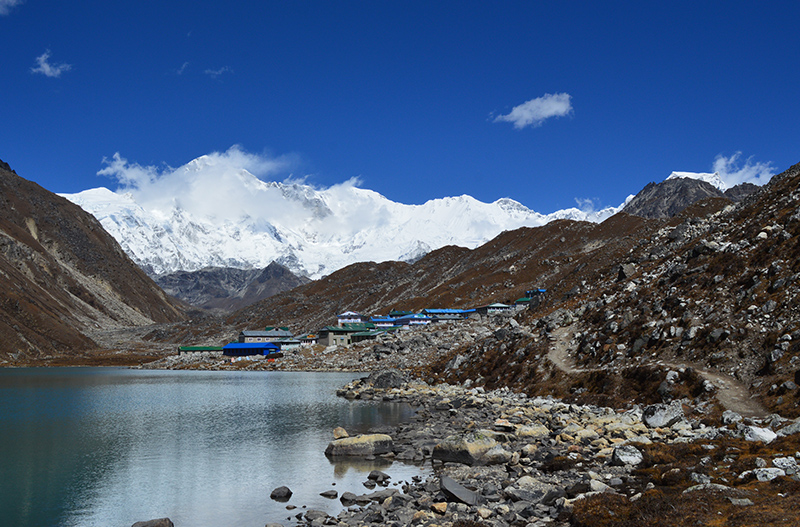
Trip Overview
Gokyo is situated in the valley of the Khumbu region. Gokyo village is one of the Himalayas’ silent treasures. Gokyo trek includes Gokyo Lake and Gokyo Ri trek which are the two most popular treks in the Everest region after Everest Base Camp Trek.
From Gokyo Ri, one can enjoy the spectacular view of Mt. Everest (8,848m), Mt. Makalu (8,463m), Mt. Lhotse (8,201m) and Mt. Cho Oyo (8,201m). Ngozumpa Glaciers, Gokyo valley, monasteries, remote settlement are the other major attractions in connection to this trek.
The trailhead is Lukla for this trip. The trek lies within the Sagarmatha National Park.
Gokyo Ri is at the same altitude as Everest Base Camp and is a perfect alternative to the popular Everest base Camp Trek. However, there are trekkers who want to combine these two. Gokyo lake is also known for six glacial-fed lake.
Table of Contents
Itinerary Overview
Day 1: Kathmandu to Lukla to Monjo (2835m), 5 hours.
Day 2: Monjo to Namche Bazaar (3446m), 4 hours.
Day 3: Namche rest for acclimatization.
Day 4: Namche to Tengboche, 5 hours.
Day 5: Tengboche to Pheriche, 6 hours.
Day 6: Pheriche to Lobuche, 5 hours.
Day 7: Lobuche to Gorak Shep, 4 hours.
Day 8: Gorak Shep to Everest Base Camp(5400m) – Gorakshep, 6 hours.
Day 9: Gorakshep to Kalapatthar to Dzong-La (4836m), 6 hours.
Day 10: Dzong-Laa to Thagnag (Dragnag-4700m) to Gokyo, 8 hours.
Day 11: Hike Gokyo Ri and descend to Machhermo, 6 hours.
Day 12: Machhermo to Phortse Thangna (3680 m), 4 hours.
Day 13: Phortse to Namche, 3 hours.
Day 14: Trek to Lukla, 6 hours.
Day 15: Lukla to Kathmandu.
Where is Gokyo?
It lies in the area of Sagarmatha National Park. Gokyo lake is situated at an altitude of 4700 to 5000 meter above the sea level.
When to Visit Gokyo Trek? What is the best time to trek Gokyo Lake Trek?
Best time to visit Gokyo is from September to December in winters and March to May in summers.
How much does Gokyo Ri trek cost?
Flight to and From Lukla: USD 350
ECAP: USD 30
Pasang Lhamu Village Municipality Permit: USD 20
TIMS: USD 10
Accommodation per night: USD 5
Meals per day: USD 35
Trekking Guide cost per day: USD 25 to 35
Trekking Porter cost per day: USD 20 to 30
What to pack for Gokyo Lakes Trek?
As you are trekking on the high altitude, carry necessary items only as it becomes difficult to carry heavy weight. You can carry items like warm jacket, waterproof jacket, sweater, hiking shirts, hiking pants, non-hiking shirts, Long-sleeve shirt, non-hiking pants, shorts, warm socks, warm hat, sun hat, underwear, Gloves, Towel, hiking shoes, sandals, sunglasses, water bottle, headlamp, sunscreen, Lip guard, personal medications items, sleeping bag, trekking poles.
Where to stay during Gokyo valley trek?
During the trek, we stay at tea houses. There are good hotels in Lukla and Namche Bazar, but after that there are average standard tea houses throughout the trekking route. The room has twin-sharing bed with Mountain View. It is advisable to take good quality of sleeping bag that keeps you warm even in -15 ºc.
What to eat during Gokyo Lake Trek?
In breakfast, toast bread with jam and honey, French toast, cheese toast, jam toast, toast bread with eggs and cheese, plain toast and egg items are available. Likewise, Tibetan bread, pancake, chocolate pancake, lemon pancake, cinnamon pancake, chapatti with honey, porridge etc. are available. For lunch and dinner, rice and curry, noodles, momos, soup and Tibetan-style bread are offered. Featuring on menus. A basic food in the Khumbu region is potatoes. As you ascend higher, lower will be the choice and the freshness but higher will be the cost.
What permits do I need for the Gokyo trek?
ECAP: USD 30
Pasang Lhamu Village Municipality Permit: USD 20
TIMS: USD 10
How difficult is to trek Gokyo Lake Trek?
Gokyo lies on the Everest region and has an elevation of around 4790 m. GokyoRi has an altitude of around 5360 m and is the highest hill in the world. Trekkers need to walk on the off-beaten paths that goes up and down whereby the ground is rough, rocky can be snowy and icy as well. Although the trek doesn’t require technical climbing, ropes and ice picks, however walking for long hours on the route may require a good stamina of your body. Thus, all this considerations make the Gokyo trek, a moderately difficult one.
What is the standard itinerary of Gokyo Lake Trek?
The standard itinerary for Gokyo trek is 14 days.
Why should I trek Gokyo Trek?
If you love high altitude trek, less crowded area, turquoise glacial lakes, unbelievable magnificent 360 degree views of view of Mt. Everest (8848m), Makalu (8463m), Mt. Cho Oyo (8201m), Nuptse (7855m), Pumori (7145m), AmaDablam (6856m),Lhotse (5816m) and many other Khumbu Himalayan ranges, you have a wise reason for choosing the Gokyo trek.
Is it safe to trek Gokyo Lake?
If you have maintained certain level of fitness and body has stamina of walking constantly, all walks of life, ages can trek for the Gokyo. Make sure you go slower and have acclimatization day in your itinerary. Normal health and experienced guide will the trek safe and sound.
How many hours do we hike each day?
You need to walk for six to eight hours each day.
Is porter required for the trek?
To make the trek easy and convenient, it is better to take porter. However, if you are strong enough to carry your stuffs with you, porter is not a compulsion.
Is there ATM on the way to Gokyo trek?
There is only one in Lukla and Namche but not sure about the reliability of their service. It is better to carry sufficient cash from Kathmandu.
Is there access to the internet on the way to Gokyo?
In some places like Lukla and Namche there are but as you go to upper part, the network is weak and is less accessible to the service. Some tea house may have wi-fi but it is common to ask for extra charge for using the service or charging the batteries.
Detail Itinerary
-
Day 1 Kathmandu to Lukla to Monjo (2835m) - 5 hours
Wake up early in the morning, breakfast at hotel and drive to domestic airport and fly to Lukla ( 2815m), trek from Monjo (2835m). The trial takes you through Dudh (milk) Koshi river and pine forest. We pass small groups of donkeys and yaks carrying trading goods and trek gear along the trial. The allure of the mountain is hard to resist, but we must be patient, as it is very important to acclimatize slowly and thereby fully appreciate our time at high altitude. It is the journey of first step so that we need to go slowly. Overnight stay at tea house.
-
Day 2 Monjo to Namche Bazaar (3446m) - 4 hours
The trial climbs up the Dudh Koshi Canyon, crossing from side to side passing the villages of Benkar and Chomou and through forests of blue pine, fir and juniper. Between 3600m and 4200m, birch and rhododendron predominate the trail. Solid villages with dry stone walls of the type and the lake district can be seen running down from the high meadows. After registering the name of tourist at Jorsalle, the trial undulates along the valley up to the confluence of Bhotekoshi and Dudh Koshi. This part of the trial is virtually sunless and notoriously cold and windy, the wind funneling down the gorges of both rivers. From this point, you begin the final step to Namche Bazaar. Along the trial, you can explore the Mt. Everest, Mt. Nuptse and Mt. Lhotse etc. Overnight rest at Namche bazaar.
-
Day 3 Namche rest for acclimatization
Namche is situated in a sheltered horseshoe shaped basin high above the Bhote Koshi Gorge. Terraced houses cling to the hillside. It is as developed town where banking facilities also available.
-
Day 4 Namche to Tengboche - 5 hours
From Namche, it is a steep one hour climb to Shyangboche (3720m). There are good views of Amadablam and Everest from here, and a short airfield built to serve the superb view at Everest view hotel. The trial descends from this point to the village of Khumjung (3790m). The gompa claims to possess the skull of a Yeti, though tests have shown it to be that of humble serow (a goat like antelope). The mixed forest of rhododendron, birch and silver fir contrasts with the bar slopes of the gorge and you may see musk deer and impeyan pheasant. The trial from Khumjung goes down the valley, past chortens and mani walls and soon meet the trial from Namche to Tengboche then climb steeply at first through forest then more gradually to the Tengboche. At early in the morning, a magnificient view of Kwangde (6187m), Tawache (6542m), Everest (8848m), Nuptse (7835m), Lhotse (8616m), Amadablam (6856m), Kangtega (6779m) and Thamserku (6608m) can be arrayed in a stunning panorama. Mani Rimdu festival held in full moon day of November/December.
-
Day 5 Tengboche to Pheriche – 6 hours
Descend through forest to Devuche where there are a few travellers’ lodges & nunnery. After crossing the Imja Khola on a steel suspension bridge, climb up past some mani stones to pangboche (3860m), the highest all year settlement in the valley with the HRA first aid post and some lodges. The gomba claims to have a yeti scalp and hand, which you can view for a small fee. The trial passes through the small villages of Sherpa community.
-
Day 6 Pheriche to Lobuche - 5 hours
The first part of the route passes up the long scrubby flat bottom of the valley to Phulung Kharka. It rises steadily, then drops down, crosses the river and enters Dughla (4620m) with its tea shops. From here the trial climbs higher and onto the morainee. A row of Chortens in memory of the Sherpas who have died on Everest marks the top of the climb. The spectacular view of Tawache & Nuptse can be enjoyed from Lobuche.
-
Day 7 Lobuche to Gorak Shep - 4 hours
Continue up the grassy valley beside the Khumbu Glacier morainee until the terminal morainee of the Changri Nup and Changri Shar glaciers on your left. It then becomes steeper and rougher as you climb to the top of the moraine. As it crosses an unconsolidated slope, the path changes from season to season.Usually, there are small stone cairns and tell tale signs of yak droppings to indicate the way. Then a short descend to a dry sandy area of Gorak Shep which has a small lake beyond. Mt. Pumori (7161m) can easily be seen from this point. As you follow the south ridge down, you can see Kalapatthar (5545m), the common point for viewing Everest.
-
Day 8 Gorak Shep to Everest Base Camp(5400m) – Gorakshep – 6 hours
EBC is the east of Khumbu Glaciers. After Gorak Shep, you head out through boulder strewn area, some of the rocks having inscription to the many climbers and Sherpas who have died in persuit of the summit. The trial then crosses the moraine wall and descends to the Khumbu Glaciers which you cross. Cairns mark the route which changes the path frequently. A great care is required. The round trip from Gorak Shep-EBC-Gorak Shep requires 6 hours.
-
Day 9 Gorakshep to Kalapatthar to Dzong-La (4836m) 6 hours
Descending down to Lobuche and turn to Dzong-La, a base point for Cho-La pass, one of the famous pass in Everest region.
-
Day 10 Dzong-Laa to Thagnag (Dragnag-4700m) to Gokyo : 8 hours.
The trial climbs a ridge for an excellent view to the himalaya along with Cho Oyu. The path slowly goes up and arrives at Dragnag and hike to Gokyo. Overnight rest.
-
Day 11 Hike Gokyo Ri and descend to Machhermo : 6 hours
The views around Gokyo are tremendous. To see best view, climb Gokyo Ri, small peak above the lake. Two hour climbing leads you to the peak for tremendous views of Cho Oyu, Gyachung Kang, Everest, Lhotse, Makalu, Cholatse and Tawachee and descend to Machhermo.
-
Day 12 Machhermo to Phortse Thangna (3680 m): 4 hours
On this day we descend to the Phortse. On the way we can view the mountain situated on the eastern Himalayan region. Mountains like Mt. Choyu, Lhotse, Makalu and many other peaks will excite us throughout the trial.
-
Day 13 Phortse to Namche: 3 hours
Today, the trial descends down to Namche and we can enjoy with the full moon night in the month of November/December. The colorful festival called Mani Rimdu falls with singing and dancing. Overnight at Namche.
-
Day 14 Trek to Lukla : 6 hours
The trail from Namche steeply descends to the Hillary Suspension Bridge and then continues on an easy regular trial till the Lukla. Overnight at Lukla.
-
Day 15 Lukla to Kathmandu
Fly to Kathmandu and drive to the city.
Service Details
- Kathmandu to Lukla to Kathmandu flight
- Accommodation and meals during the trek
- Conservation permit, and Pasang Lhamu village entry pass
- English Spokeaking Guide
- Necessary porters
- Domestic airport pick up and drop
- Staff allowance and their insurance
- Arrival pick up and departure transfer
- Kathmandu accommodation if need
- Beverages & Bar bills
- Personal expenses
- Insurance in case of emergency (Like helicopter rescue)
- Tipping and other expenses if any
- Meals during the stay in Kathmandu
Date & Availability
- Trip Duration:
14 Days
- Trip Region:
Everest Region
-
Trip Start From:
Kathmandu
-
Trip End In:
Kathmandu
- DailyWalking Hour:
5 to 6 hours
- Trip Route:
- Trip Season:
September to November and March to May
-
 Activity Level:
Activity Level:Moderate Trek
Quick Inquiry
Trip Reviews
Photo Gallery
